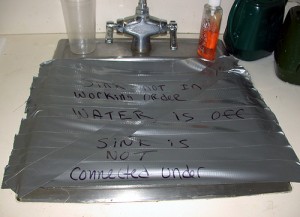
duct tape and water, courtesy Metropolitan Library System, used with permission, some rights reserved
It’s just geographical coincidence that Horst Rittel and Melvin Webber were at Berkeley in 1973 when they published their Dilemmas in a General Theory of Planning (pdf), less than 30 miles as the American white pelican flies from Sherman Island at the downstream mouth of the Sacramento-San Joaquin Delta. But as we await tomorrow’s unveiling of the latest effort to fix the Delta, it’s worth revisiting Rittel and Webber, because I’ve seen few better case studies of “wicked problems” than this:
Policy problems cannot be definitively described. Moreover, in a pluralistic society there is nothing like the undisputable public good; there is no objective definition of equity; policies that respond to social problems cannot be meaningfully correct or false; and it makes no sense to talk about “optimal solutions” to social problems unless severe qualifications are imposed first. Even worse, there are no “solutions” in the sense of definitive and objective answers.
The most useful formulation of the “wicked problem” thesis, for me, involves two elements. The first is that one’s definition of the problem suggests the solution path. The second is that there is no unique problem definition, but rather multiple possible definitions, suggesting multiple different solution paths, based on the values and the interests of the person doing the defining.
Watching the Bay Delta Conservation Plan pre-show, as all the players stake out their ground prior to tomorrow’s announcement by the state of California and the Feds, has been to see Rittel and Webber reified. Consider a few of their criteria for what counts as a “wicked problem”, and how these criteria might apply here:
- There is no definitive formulation of a wicked problem
- Wicked problems have no stopping rule
- There is no immediate and no ultimate test of a solution to a wicked problem
- Every wicked problem can be considered a symptom of another problem
Nowhere is this more obvious than the valiant attempt by Californians to constrain the definition of the problem the BDCP is attempting to solve (quoted from the recent state-federal joint recommendations – pdf):
the two coequal goals of providing a more reliable water supply for California and protecting, restoring, and enhancing the Delta ecosystem
The explicit mantra – “coequal goals” – was an attempt to sidestep the core of the wicked problem – the lack of a definition. Was the ecological collapse of the Delta the problem? Or was it the lack of water supply reliability? Each problem definition, separately, suggested a different set of solutions. So the state’s political leadership tried to duct tape them together, really tightly.
In fact, the Sacramento-San Joaquin Delta Reform Act of 2009 has a lot more duct-taped in. The protection and enhancement of the Delta itself (carefully defined in cultural, recreational and agricultural terms as “an evolving place”, for example), and some particularly critical language about state government’s policy to “improve the water conveyance system” and “to reduce reliance on the Delta in meeting California’s future water supply needs”.
“There is no problem,” one of the state’s smart senior water politics-policy people told me when I was out in California last year. “There are multiple problems.”

Really gets at the dilemma, John – and please, do tell – any sense that this last few days’ events have gotten any closer to solving this? Feels very much ado about nothing to me…
John – I think your comment – “what was the new news these groups were reacting to?” – got to the heart of it. Matt Weiser’s take on the “new” is the closest to my understanding of what might be new – “What is new is the federal government’s commitment to the project.” Which is in a formal sense true. But not really. We’ve known for a while they were on board with the tunnel.
So what we’ve got is an opportunity this week for everyone to get on the record what they already have said in the past.
But I haven’t had the chance to listen to the news conference or read all the pronouncements.
Pingback: California water’s “grumpy old guy” on BDCP : jfleck at inkstain
John,
Thanks for this article and for the reference to Rittel and Weber. I downloaded their PDF.
When I look at such problems my first question is ‘Does the problem have a solution?’ My second question is ‘Is there a solution within the set of assumptions that people are making about the problem?’ Here the answer is often no for the reasons that you, Rittel and Webber state. My next question is ‘Can people’s conditions on the solution be changed enough so that there is a solution?’ Here the answer is often ‘No, unless a crisis occurs.’ My tentative reason for people’s unwillingness to change their conditions is that they feel that if they change their conditions, they will lose out on a promotion, make enemies, or be fired. To me at the moment, there are no wicked problems, but there are a lot of really hard ones. We need more politicians in the good sense that you describe.
Pingback: Thinking about California headwaters : jfleck at inkstain